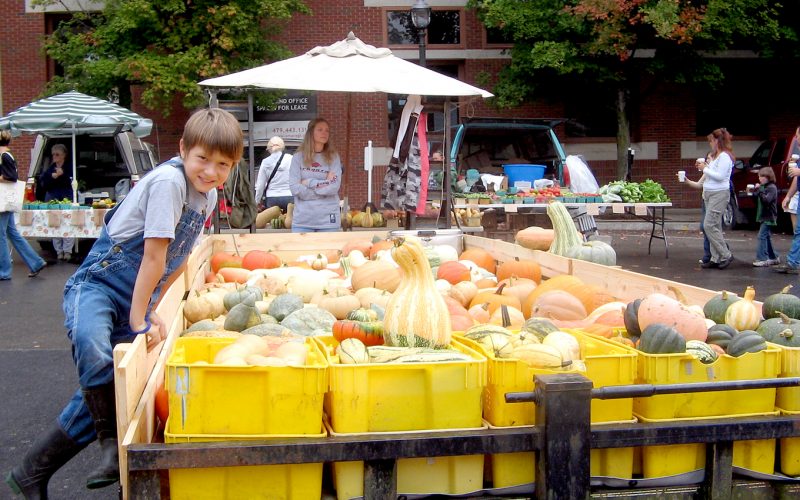
Staff Photo Amanda Bancroft
Festive pumpkins and gourds for sale at the Fayetteville Farmer’s Market on the downtown square.
It’s officially autumn, and time for celebrations involving our largest native fruit, the pumpkin. Yes, pumpkins are scientifically classified as fruits, not vegetables: they belong in the same family as cucumbers, melons, and squash. We commonly refer to pumpkins as well as tomatoes, bell peppers, and green beans as vegetables, but they’re all fruits. Pumpkins are specifically winter squash, and surprisingly, they are berries too!
Pumpkins originated in North America, with the oldest evidence from Mexico, and have been important in the diets and cultures of many peoples. Like most of our crops, pumpkins depend on native pollinators – in this case, the squash bee. Squash bees are specialist pollinators, more effective than honeybees at pollinating some plants in the pumpkin family.
The Three Sisters is a form of companion planting practiced by Native Americans, growing squash along with corn and beans. Corn provides a natural trellis for the beans to grow on. The bean roots nourish the corn by adding nitrogen to the soil. On windy days, the bean vines stabilize the corn stalks. The big-leaved squash plants shelter the shallow roots of the corn, and shade the ground to preserve moisture and discourage weeds from growing.
Pumpkins are prominently present in many stories, including ones you may have heard of involving glass slippers, Peanuts characters, and horsemen. But here’s one you may not have heard. Carving jack-o-lanterns is a popular Halloween activity, and although the term first appeared in 1837, the legend goes back farther to an Irish story called “Stingy Jack,” and actually started with carved turnips. In this remarkable myth in which Satan is somehow trustworthy, an Irish drunkard named Jack tricks the devil into giving his word not to take his soul to hell. However, when heaven rejects his soul, Jack can’t get into hell either! Satan gives him an ember burning inside a turnip to carry forever in the netherworld as a warning to others. Irish immigrants to America found pumpkins a plenty and easier to carve than turnips, and now we have the jack-o-lantern.
Luckily, pumpkins not only have a tasty role to play in our history, but are nutritious, too. Pumpkins are a great source of Vitamin A (they get that beautiful orange color because of the antioxidant beta-carotene) and are low in calories, sodium, and fat. Their seeds are a good source of protein, copper, magnesium, and zinc. It’s good for dogs and cats as well: if your pet suffers from digestive ailments, pumpkin has been recommended by some veterinarians because its fiber content aids in digestion. Unfortunately, outside of pumpkin-flavored everythings, pumpkins are no longer a staple part of the traditional American diet (with the exception of Thanksgiving pie). It doesn’t have to be a dessert to taste great, though: why not try savory dishes like pumpkin soup, chili, or spicy pumpkin curry in coconut milk?
Amanda Bancroft is a Master Naturalist and volunteers with her husband Ryan for their solar-powered online educational center on how to make a difference with everyday choices at: www.RipplesBlog.org.










